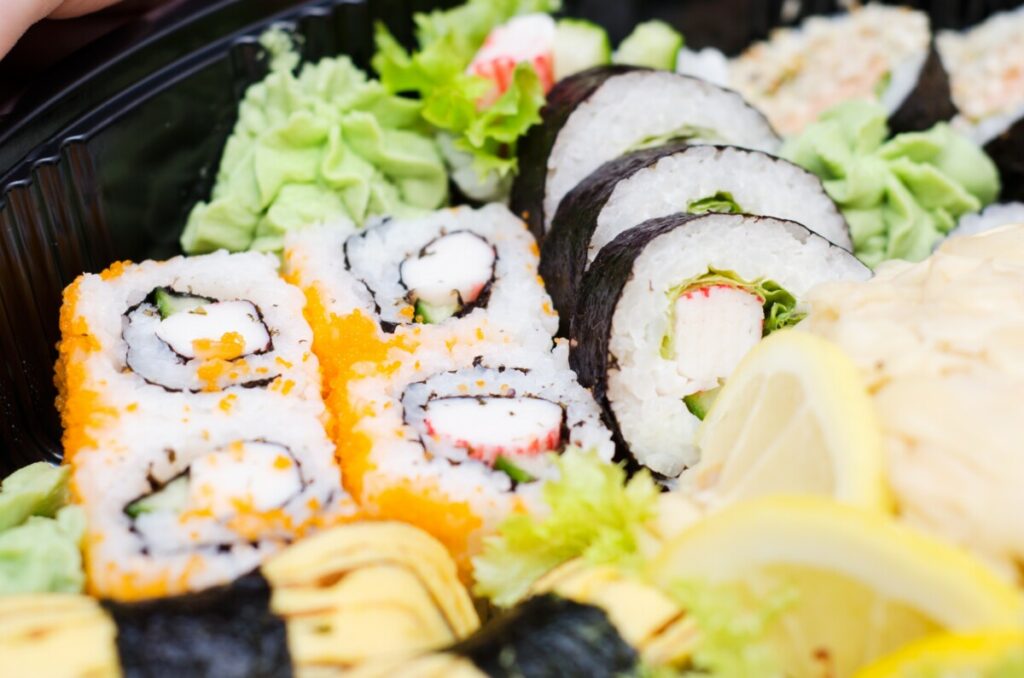This post contains affiliate links.
When serving food to others, it can be challenging to learn all the needed information to safely serve the food. Learning how to properly handle food is extremely important, especially raw foods like sushi. So, at what temperature should sushi be served at?

Sushi is best when served at room temperature, which is around seventy degrees Fahrenheit. Eating sushi at room temperature allows the different flavors to be pronounced. In hot months, it is best to store sushi in the fridge up until ten minutes prior to consumption.
There is a lot of information that is beneficial to know when handling sushi. It is important to ensure that sushi is served at the correct temperature. After completing the research, the following information has been compiled below.
The Correct Temperature for Sushi
For many types of sushi, it is best to serve at room temperature. Serving at this temperature allows all the flavors of the sushi to be distinct while still ensuring the sushi is safe to consume.

When serving sushi, the sushi rice should still be somewhat warm. This allows the sushi to overall be at room temperature because the fish included in the sushi is typically colder than the rice.
Most sushi is best when it is consumed shortly after being rolled. While it is possible to store sushi, it is suggested not to eat sushi that has been in the fridge for over twenty-four hours.
There are some types of sushi that are preferred by some to be served at a temperature colder than room temperature, and there are others that are served at a warmer temperature.
Why Room Temperature?
Not only does serving sushi at room temperature ensure that the ingredient’s distinct flavors are present, but it also ensures that the sushi remains safe for consumption.
The fluctuation in the temperature can cause the raw fish to have bacteria that can make any individuals who consume it get sick. Serving sushi at room temperature ensures that the raw fish is still safe for consumption.
Room temperature allows individuals to prepare the sushi to ensure that all the ingredients are still safe to eat. If each ingredient needed to be served at a different temperature, it could be challenging to ensure that each part of the sushi was served at the ideal temperature.

How Long can Sushi be Stored at Room Temperature?
It is important that leftover sushi does not stay at room temperature for longer than two to four hours. If it stays at room temperature for this long, it can develop bacteria that can lead to food poisoning.
If the sushi has only been at room temperature for two or fewer hours, it is safe to place the sushi in the fridge before eating the leftovers. However, if the sushi has been out longer than two hours but less than four hours, it can still be safe to eat, but not recommended to be stored to be eaten at a later time.
Sushi that has been at room temperature is stored at room temperature for longer than four hours and should not be consumed. Eating this sushi will most likely result in food poisoning.
It is recommended to place the remaining sushi in the fridge as soon as an individual is aware that there are going to be leftovers. This ensures that the remaining sushi is still safe to be consumed at a later time.
Types of Sushi
There are many different types of sushi that contain raw fish, but there is also sushi that contains cooked fish and even vegetarian sushi that contains no fish at all.

There are five major types of sushi that are known by sushi consumers. These types include nigiri, sashimi, maki, uramaki, and temaki. Some of these types of sushi can be prepared either cooked or raw.
Nigiri is a type of sushi that can be served with either cooked or raw fish. This makes it great sushi for individuals wanting to try sushi but are uninterested as a result of the idea of raw fish. Nigiri is not structured like most anticipate sushi being structured. This type of sushi is very simple and only has two ingredients. It consists of only some types of fish (raw or cooked) over sushi rice.
Like nigiri, Sashimi is also extremely simple. Rather than having multiple ingredients, this type of sushi only includes raw fish. It is not served with any rice or vegetables. The plate can sometimes be garnished with ice or other items, but sashimi is typically eaten on its own. This type of sushi would be best for individuals who already know that they like the taste of raw fish.
Maki is the type of sushi that people think of when they think of sushi. It has sushi, fish, and other ingredients such as vegetables wrapped in seaweed. This sushi is served in the form of rolls.

Uramaki is similar to maki rolls. The biggest difference between these types of sushi is the fact that the rice is on the outside of the seaweed rather than on the inside with the fish and vegetables. Uramaki is also served in roles like maki, but traditionally has some type of sauce drizzled on top. The most common type of sauce on Uramaki is spicy mayo.
The final type of sushi is temaki. This is very similar to maki and uramaki. However, instead of being rolled and cut into small rolls, this type of sushi is rolled into a cone shape. Temaki is not types of sushi that can be easily shared with others because it is not cut into smaller pieces like the other types of sushi.
Common Types of Fish Used in Sushi
There are many different types of fish that can be used in sushi. It is important to ensure that the fish that is being used is deemed sushi-grade fish. This guarantees that the fish is safe to be consumed raw.
One of the most common types of fish used in sushi is salmon. In the United States, this is one of the cheaper types of fish, which makes it easy for individuals to have access to it. It is important when using salmon to ensure that the salmon is handled properly in order to avoid bacteria or parasites that can make individuals who consume it ill.
Another type of fish that is commonly used in different types of sushi is tuna. It is important to note that consuming too much tuna is not good. Some types of tuna can act as a natural laxative.
Cold Served Sushi
Some sushi lovers might prefer their sushi to be closer to refrigerator temperature rather than room temperature. This is more common for sashimi than it is for other types of sushi. Individuals prefer the raw fish on its own to be at a colder temperature than room temperature.

For some, eating sashimi straight out of the fridge allows them to feel more secure that the raw meat does not have any bacteria that could potentially lead to food poisoning.
Serving sushi cold can lead to the rice having a different texture than the room temperature sushi rice will. Other than the rice being more crumbly as well as slightly drier, there is not a great difference when it comes to the difference between room temperature sushi and cold sushi.
Warm Served Sushi
The most common type of sushi that is eaten warm is deep-fried sushi. While this style of sushi is not as common as traditional sushi, it is enjoyed by some sushi lovers.

While some individuals think deep-fried sushi is off-putting and untraditional, others find the deep-fried tempura batter surrounding the sushi roll to make the warm temperature of the sushi to be worth it.
The warmth from being deep fried causes the sushi to be somewhat creamy as a result of all the flavors melting together. This melting of flavors is something that individuals either like or really dislike.
Handling Sushi Safely
It is important to ensure that the fish that is being used is fresh. If the fish has been purchased raw and fresh, it needs to be used within twenty-four hours in order to guarantee that there are no bacteria that have developed.
If the type of fish being used in sushi is salmon, it is important to make sure that it is frozen for twenty-four hours before being used in the sushi. This is how to properly prepare salmon without having to worry that there are remaining bacteria or parasites on the meat.

It is important that sushi is served shortly after being rolled. This allows the sushi to remain as fresh as possible and allows the individuals eating it to have the best sushi experience possible. It also does not allow the fish to have time to start going bad before it is consumed.
Like any food, it is important to guarantee that the sushi is being prepared by an individual who has thoroughly washed their hands. This lowers the chances of the sushi getting bacteria on it as a result of being touched by an individual who does not have clean hands.
Benefits of Cooked Sushi
There are some benefits to having cooked sushi rather than eating raw sushi. With cooked fish in sushi, it can last in the fish longer than it would if the fish were raw. Sushi with raw fish can only last up to twenty-four hours in the fridge. However, sushi with cooked fish can last two to three days in the fridge.
Another benefit is that there is no risk of getting sick when consuming cooked sushi. When the fish is cooked, any bacteria that could have been present is cooked out.
Cooked sushi can be consumed by individuals who are uncomfortable with the idea of consuming raw meat. This allows all individuals to have the opportunity to try sushi.

Can Leftover Sushi be Reheated?
While some individuals prefer to eat leftover sushi straight out of the fridge, many individuals prefer heating up the leftovers in the microwave for only thirty seconds. This allows the rice to be warmed, and the seaweed to crisp up a bit.
Sushi should not be heated in a microwave for longer than thirty seconds because it could result in changing the texture of the sushi completely.
If the sushi was served warm, there should be very little concern about changing the texture when reheating in the microwave. The tempura deep-fried batter around the sushi roll might be soggier as a result of being reheated in the microwave.
Tips for Preparing Sushi
Sushi is a type of food that can be very expensive when ordering from a restaurant, which is why many individuals are interested in learning how to make their own sushi at home. Before starting this hobby, there is some information that can be extremely beneficial to learn.

When placing down the rice, it can be helpful for the individual preparing the sushi to wet their fingertips. This allows the rice to be flattened on the seaweed while avoiding the rice sticking to the fingertips.
Some individuals have learned that it is easier to work with rice that has cooled down completely to room temperature rather than trying to spread the rice on the seaweed while the sushi rice is still warm. This differs for each individual, so it is important to figure out which method is best.
There are some items of cookware that can make this process a lot easier. A rice cooker can make it easier to prepare the rice rather than following the instructions on the back of the rice package. Either a rice paddle or a wooden spoon can be beneficial in moving the rice around as well as spreading the rice thinly on the seaweed. A bamboo rolling mat can make rolling sushi extremely easy! However, it is possible to roll sushi without a bamboo rolling mat by using plastic wrap.
Just remember to always be safe when eating sushi!
